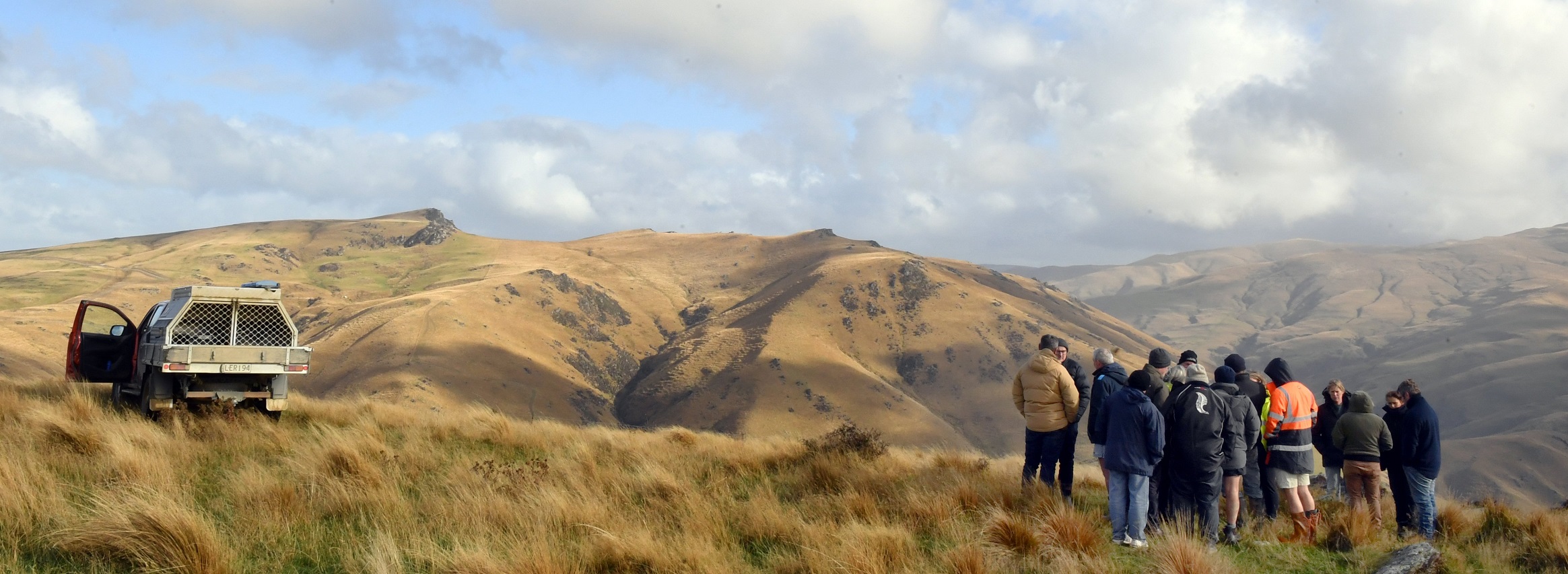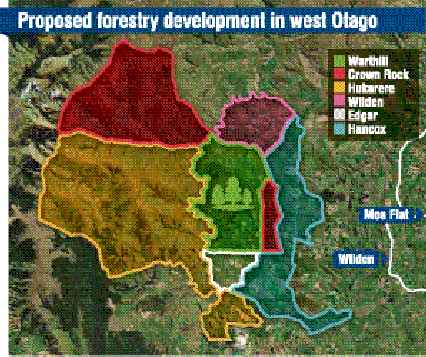
Business and rural editor Sally Rae reports.
A group of West Otago farmers — concerned about the ramifications of a neighbouring forestry development — are outraged a wilding tree risk assessment was completed by one of the forestry company’s employees, likening it to "marking your own test".
They fear Ernslaw One’s conversion of Warthill, a 2500ha property in Wilden Runs Rd, could lead to a repeat of the "environmental disaster" seen in other parts of the country with wilding tree spread.
But the forestry company says it is not a conflict of interest and it is standard practice in the industry for staff to conduct the assessments. The employee who completed the assessment was a professional forester with 45 years’ experience and the company maintained the assessment was accurate, Ernslaw One said.
On Monday, the farmers met at Hukarere Station, home of Quintin and Rebecca Hazlett and a neighbour of Warthill, to outline their concerns to Otago Regional Council staff and Cr Lloyd McCall.
On Wednesday, ORC manager compliance Tami Sargeant confirmed the council had requested additional information from Ernslaw One and was getting an independent assessment of the wilding risk calculator score.
While it is understood spraying is under way on the property, Ms Sargeant said the council could not require Ernslaw One to cease the planned activity at this stage.
The farmers were told at the meeting that Ernslaw One had met the afforestation requirements under the National Environmental Standards for Commercial Forestry (NES-CF), meaning it was considered a permitted activity and consent was not required.
One of those requirements was a wilding tree risk assessment which, if it achieved a score of 12 or more, meant it was not a permitted activity and resource consent had to be obtained. The highest score within the block was 11.
The group had done their own assessment, and they knew the weather patterns and their stocking rates, and came up with a score of 16 and 17, so they were astonished how 11 could be reached, the farmers said. Alice Stewart questioned the point of even having to get a calculation done — "if no-one’s going to question you".
Of the area to be planted, about 1100ha was Douglas fir, which had high wilding potential, the farmers said. Once the trees started seeding, the farmers feared the surrounding run blocks would become covered with wildings.
Most of the surrounding properties were running below the five stock units per hectare required to control them. Wilding trees and the associated increase in pests from forestry would add costs to the surrounding run blocks, which they believed would eventually be worthless to sell as run blocks, the only option being to sell to further forestry.
An emotional Fiona Hancox said Warthill was a "huge block" of land, in a vulnerable area, and the development had "lots of ramifications for lots of people".
It was "beautiful unspoilt farmland doing beautiful protein", which would be swapped for pine trees and Douglas fir "which we ship off ... to places overseas or burnt in Gore to do biofuel". "Do you want beautiful protein or it going up in smoke? she asked.
Rebecca Hazlett implored the council to "do the right thing". "I know the rules are the rules but you guys still have to do the right thing. I think you ... need to find a way to do the right thing. The buck stops with you ... you’ve got a chance to stop this and make it right. You need to do that," she said.
Ms Sargeant said it was always helpful to meet farmers and the community to understand concerns. The council was continuing to review the information supplied for the afforestation activity and monitor compliance with the NES-CF.
She said the risk calculator was completed by a suitably competent person. The Ministry for Primary Industries’ user guide stated "it is expected that most large forestry companies will have staff or contractors who are capable of using the wilding tree risk calculator. For smaller operators or farmers seeking to establish woodlots, they may have to engage specialist assistance to complete the calculator".

Neighbours have previously had meetings with Ernslaw One management to express their concerns, which also included the potential for increased pests, fire risk, devaluation of their properties and deterioration of the Pomahaka River.
In 2022, Ernslaw One was fined $225,000, to be paid to the Gisborne District Council, and a total of $130,000 in emotional harm reparations to several victims, for its part in widespread damage to homes, farms and infrastructure near Tolaga Bay, which occurred during a storm at Queens’s Birthday Weekend in 2018.
At sentencing, RNZ reported Judge Brian Dwyer spoke of the "high degree of failure" by the company and its lack of effort to make amends and help the victims. It later had its Forest Stewardship Council Certification suspended.
Responding to questions from the Otago Daily Times, regional manager Phil de la Mare said the company would make the workings behind the score available to neighbours if it alleviated their concerns. It had already advised the ORC it could exercise the option of an independent assessment if required.
Ernslaw One was operating under the NES-CF regulations and it would also have an ongoing wilding management programme that included close management and monitoring of boundaries, regular engagement with neighbours and proactive remediation if wilding spread did occur. A third meeting with neighbours was scheduled in May to discuss their concerns.
The company had installed an anemometer to monitor wind spread and direction and it was not required to be an expert on stock grazing under the NES, Mr de la Mare said.
Forestry had been part of West Otago for 120 years and the district could not be compared with the Mackenzie district, which did not have commercial forests and had inherited wilding spread from Ministry of Works amenity plantings of Pinus contorta and Corsican pine as part of the 1960s hydro developments, or the Lake Onslow area which had stands planted on sites "which commercial forestry wouldn’t contemplate, let alone qualify under the NES-CF calculator", he said.
When contacted, the MPI said the person undertaking the assessment was required to have the suitable level of qualifications and/or experience to understand and perform it. That was regardless of whether they were external or internal to the forestry company undertaking the planting.
If the person did not meet those conditions, the activity was no longer a permitted activity. If councils received a score for a commercial forest that they believed did not meet the permitted activity conditions in the NES-CF, they may challenge the assessment.
If it no longer met the permitted activity conditions, it would require a resource consent as a restricted discretionary activity.
"This means councils can apply the matters to which discretion is restricted to in the NES-CF to manage the risk of wilding conifers, or where the risk is deemed too great to be managed, they can decline the resource consent".
The wilding tree risk and control regulations in the NES-CF were recently amended. As of April 3, further evidence of how the wilding tree risk calculator assessment was reached was now required to also be provided with the calculator score.
Cr McCall said the council had to implement national standards "as they are written" and those standards were enabling of forestry establishment.
If the ORC went beyond what it was required to do, it would be open to legal challenge by the forestry industry and discussions with the ministers involved.
Asked for a ballpark figure for the annual cost to the ORC for removal of wilding trees, Ms Sargeant said the council did not contribute funding directly. Funding for control work in the Otago region was received from the MPI for delivery of the National Wilding Conifer Control Programme. A total of $230,000 in funding had been provided by the ORC to community wilding control groups across the region in this financial year.












